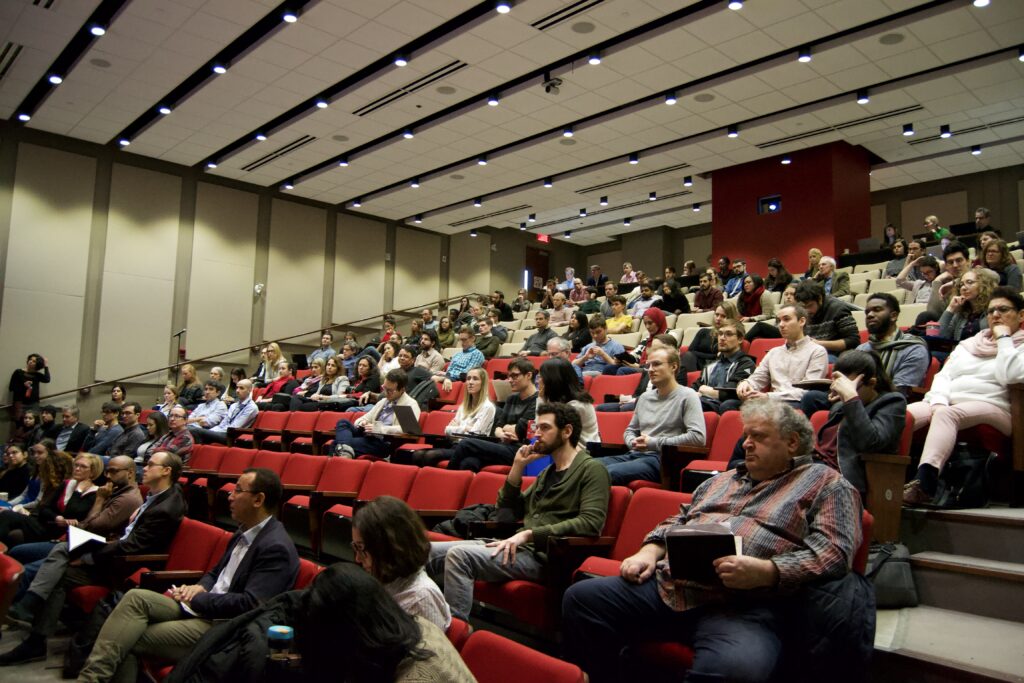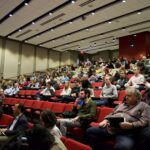Despite a raging snowstorm characteristic of Montreal winters on February 7th, attendance at this year’s annual QBIN Scientific Day was higher than ever, with almost all of the 220 registered participants from across the province braving the weather to attend the event. Some attendees even made their way over from Toronto and Marseilles, and although weather-related flight cancellations prevented one of our keynote speakers from attending, the bad weather did not stop the day from being a big success!

This year, the Scientific Day was organized according to three themes:
The morning session on bio-imaging in animal models yielded interesting discussion on preclinical research. From new imaging tracer development to studies on cancer and Parkinson’s disease, all speakers highlighted how they use different imaging modalities to track disease progression or monitor potential treatment. The panel discussions following the talks were an informative way to discuss common themes across topics, for example how animal work can translate to human studies, and the benefits and drawbacks of using imaging techniques that only capture macroscopic effects.
Another strength of Québec’s bio-imaging community is the development of innovative methodological advances. The talks on this theme gave an overview of magnetic resonance spectroscopy, a method to measure the concentrations of different metabolites in the body, advances in the field of nanoscopy, and the development of new techniques for medical imaging based on ultrasound.
The closing session touched upon some of the many clinical applications of bio-imaging and human studies. Three young investigators spoke about brain and genetic differences in development, a brain imaging signature of pain, and how the brain perceives auditory information.

Parallel to the talks and panel discussions, three themed poster sessions gave trainees the opportunity to present their latest work. 57 posters were presented by students and postdocs, who account for 60 percent of the entire QBIN membership
A novelty this year was the inaugural Rising Star in Bio-Imaging lecture, presented by Dr. Maxime Descoteaux. He gave an insightful overview of the use of diffusion-weighted magnetic resonance imaging, a technique that allows scientists to study the anatomical connections in the brain (called white matter) that allow for communication between brain regions. In addition to summarizing advances from the past 15 years of research in the field – many of which Dr. Descoteaux contributed to himself – he highlighted the use of multimodal neuroimaging and innovative algorithms for reconstructing white matter tracts in the brain.
Finally, this year’s William Feindel lecture was given by Dr. Hedvig Hricak from the Memorial Sloan Kettering Cancer Center in New York. Dr Hricak is a pioneer in the use of positron emission tomography (PET) in cancer research and gave a fantastic overview of the latest research in oncologic imaging. In spite of having to join us via video conference due to weather-related flight cancellations, Dr. Hricak’s talk was highly engaging, and truly fascinating.

The organization team also took this opportunity to introduce the new QBIN coordinator: Carole La Madeleine, who will be based in Sherbrooke and will be responsible for coordination and administration of the network. We also said farewell to our veteran coordinator, Francine Belanger, who will be retiring this spring. Francine has been the beating heart of QBIN for many years and will be dearly missed. We wish her all the best in her retirement!
As part of their annual update on the network, the QBIN management team presented ways in which students and faculty can get involved in the network. In addition to being eligible to apply for the many funding opportunities provided by QBIN, members can participate in several new science communication initiatives, including contributing to the blog, joining the student communications committee, submitting images to the Art of Imaging project, and sending news and announcements for the website and monthly newsletter. In addition, we (the student communications team) announced that we are planning a Science Communications Hackathon, an opportunity that will allow members to get together and work on projects aiming to communicate science to the public (stay tuned for more information on that as soon as circumstances allow in-person events again). Last but not least, the Scientific Day marked the official launch of the QBIN Blog, which you are currently reading!
This year’s Scientific Day was a huge success, with a great turnout even in the wake of a massive snowstorm (talk about commitment to science!). We are excited to integrate the feedback received from attendees in the planning of next year’s Scientific Day, including the possibility of hosting the event in Sherbrooke or Quebec City. Stay tuned!






